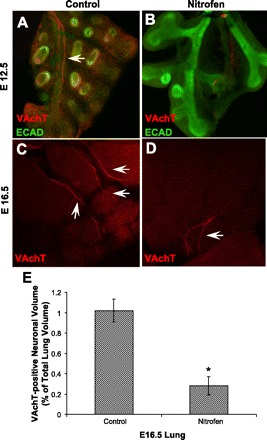Fig. 5.

Comparison of pulmonary parasympathetic innervation in embryonic murine control and nitrofen-treated lungs using the parasympathetic marker vesicular acetylcholine transporter (VAchT). A–D: VAchT immunofluorescent staining in confocal images of embryonic lung whole mounts from control and nitrofen-treated mice at E12.5 and E16.5. In control lungs at E12.5 and E16.5, there is a fine network of VAchT-positive nerves as early as E12.5, with increased complexity of branching into the periphery as gestation proceeds. In nitrofen-treated embryonic lungs, there is a less complex pattern of VAchT-positive innervation, with decreased neural branching from central nerve trunks at each gestational age. These results suggest a relative decrease in parasympathetic innervation in nitrofen-treated embryonic lungs. Arrows, VAchT-positive nerves. Original magnification ×100. E: VAchT-positive neuronal volume in control and nitrofen-treated murine lung at E16.5. Neuronal volume was calculated using z-stack images obtained from confocal microscopy of whole mounts and expressed as percentage of total lung volume. *P < 0.05.
